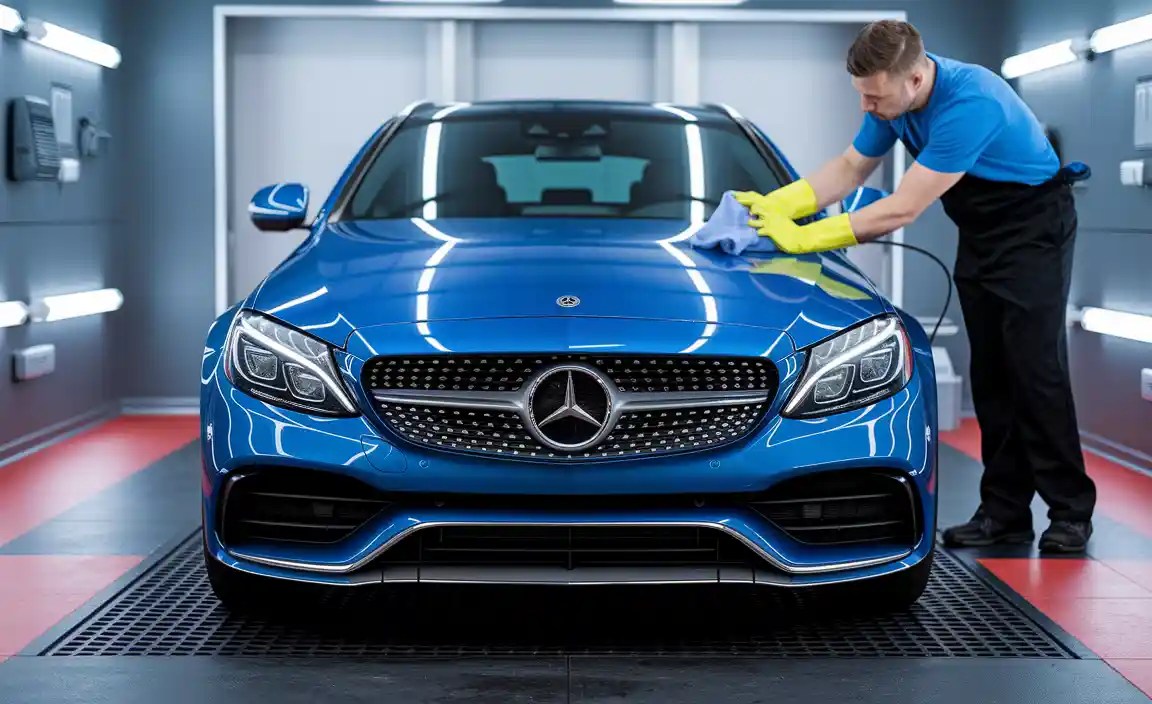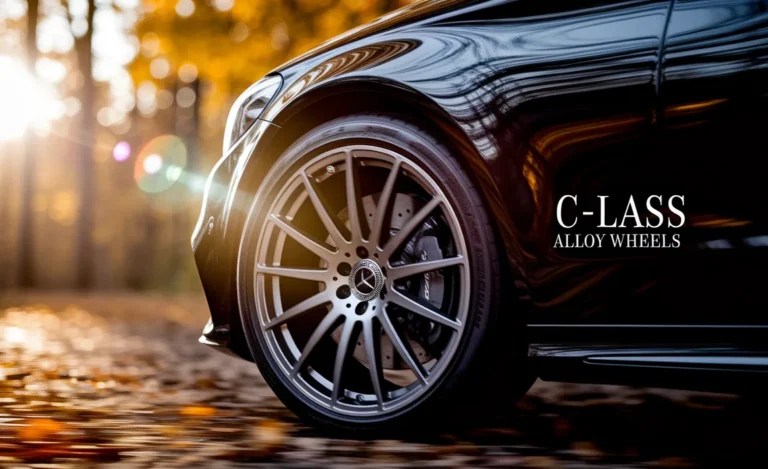Mercedes-Benz C Class Cleaning: Ultimate Essential Guide
The C-Class you drive is a marvel of engineering and luxury. Keeping it clean is essential for maintaining its pristine look and protecting its value. This guide provides essential, easy-to-follow C-Class cleaning tips, from exterior sparkle to interior comfort, ensuring your Mercedes-Benz always looks and feels its best.
Your Mercedes-Benz C-Class represents a blend of sophisticated design and driving pleasure. Over time, everyday use can dim its shine, leaving you frustrated with dull paint and a less-than-inviting cabin. But achieving that showroom new look doesn’t require a professional detailer or a huge budget. With the right approach and some essential C-Class cleaning tips, you can easily maintain its elegance yourself. We’ll walk you through every step, making the process straightforward and rewarding.
This guide is designed to be your go-to resource, whether you’re cleaning your C-Class for the first time or looking to refine your routine. We’ll cover everything from safe washing techniques to interior detailing. Get ready to transform your car’s appearance and enjoy the pride of owning a meticulously cared-for Mercedes-Benz.

Why C-Class Cleaning Matters
A clean Mercedes-Benz C-Class isn’t just about aesthetics; it’s a crucial part of ownership that impacts several key areas. Regular cleaning helps preserve the vehicle’s finish, preventing damage from harmful contaminants and ensuring its long-term beauty and resale value.

Beyond looks, a clean interior creates a more comfortable and enjoyable driving experience, contributing to your overall well-being on the road.
Protecting Your Investment
Your C-Class is a significant investment. Just like any other valuable asset, it requires maintenance to retain its worth. The exterior paintwork, for example, is constantly exposed to environmental hazards: UV rays that fade color, bird droppings that etch the finish, road salt that corrodes metal, and industrial fallout that leaves stubborn stains. Consistent washing and protection remove these threats, preventing permanent damage and keeping your car looking newer for longer. This proactive approach to cleaning is fundamental to preserving the resale or trade-in value of your Mercedes-Benz.
Enhancing Driving Experience
The interior of your C-Class is your personal space on wheels. A clean and well-maintained cabin contributes significantly to your comfort and driving pleasure. Removing dust, spills, and debris not only makes the interior look better but also improves air quality through effective cleaning of surfaces and carpets. A fresh-smelling, tidy interior can reduce stress and make every journey more relaxing. It’s about creating an environment where you can truly appreciate the luxury and craftsmanship Mercedes-Benz is known for.
Preventing Long-Term Damage
Ignoring dirt and grime can lead to more than just an unsightly appearance. For instance, acidic contaminants like tree sap or acidic fallout can bond to the paint surface. If left unchecked, these can slowly eat away at the clear coat and paint, leaving permanent marks that are difficult and expensive to repair. Similarly, dirt trapped in door jambs or under seals can cause friction and wear over time. Regular cleaning is a preventative measure that saves you from costly repairs down the line.
Getting Started: Essential Tools and Supplies
Before you begin, gathering the right tools and supplies is crucial for an effective and safe cleaning process. Using the incorrect products or methods can lead to scratches or damage, especially on a premium vehicle like your C-Class. Here’s a breakdown of what you’ll need:
For the exterior, think about what encounters the paint and what washes it away. For the interior, focus on gentle yet effective cleaning for various surfaces.
Exterior Cleaning Essentials
- Two Buckets: One for soapy water (wash bucket) and one for rinsing your wash mitt (rinse bucket). This prevents dirt from being spread back onto the car. Consider adding grit guards to the bottom of each bucket to trap dirt.
- High-Quality Car Wash Soap: Use a pH-neutral car wash shampoo specifically designed for automotive paint. Avoid dish soap or household detergents, which can strip protective waxes and damage clear coats.
- Wash Mitts: Opt for microfiber or lambswool wash mitts that are gentle on paint. Have at least one for the body and a separate one (or even a different material) for dirtier lower sections or wheels.
- Wheel Cleaner: A dedicated wheel cleaner is important, as brake dust can be corrosive. Choose a pH-neutral or acid-free cleaner suitable for your C-Class’s wheel finish (alloy, chrome, painted).
- Wheel Brushes: A soft-bristled brush for the wheel faces and a stiffer one for the barrels and tire-cleaning brushes are necessary.
- Drying Towels: Large, plush microfiber drying towels are essential. Look for “waffle weave” or “twisted loop” designs, which absorb water efficiently and are less prone to scratching.
- Microfiber Detail Cloths: For wiping down windows, door jambs, and applying spray waxes or sealants.
- Hose with a Spray Nozzle: For rinsing the vehicle effectively. A pressure washer can be used with extreme caution on a low setting, but a standard hose is safer for beginners.
- Optional: Bug and Tar Remover: Handy for stubborn spots that regular soap won’t lift.
Interior Cleaning Essentials
- Vacuum Cleaner: With various attachments (crevice tool, brush attachment) to reach all areas.
- Interior Cleaner: A multi-purpose interior cleaner safe for plastics, vinyl, and leather. For leather seats, a dedicated leather cleaner and conditioner are highly recommended.
- All-Purpose Microfiber Cloths: Separate cloths for dashboards, consoles, glass, and doors.
- Glass Cleaner: A streak-free ammonia-free glass cleaner.
- Upholstery Cleaner (if needed): For fabric seats or carpets.
- Detailing Brushes: Small, soft brushes for cleaning air vents, seams, and intricate areas.
- Leather Conditioner: To keep leather seats supple and prevent cracking.
- Carpet/Floor Mat Cleaner: To tackle dirt and stains on carpets and mats.
Step-by-Step Exterior Cleaning Guide
Keeping your C-Class’s exterior in top shape involves a careful, methodical approach. We’ll cover washing, drying, and basic protection.

1. Pre-Rinse
Start by thoroughly rinsing the entire vehicle with a hose. This step is crucial for removing loose dirt, dust, and debris. Spraying from the top down helps wash away loosened grime, minimizing the risk of scratching the paint when you start washing. Pay attention to wheel wells and lower body panels where dirt accumulates.
2. Wheels and Tires First
It’s best to clean wheels before the main body of the car. Wheels often accumulate the most stubborn brake dust and road grime. Spray your chosen wheel cleaner onto one wheel at a time, allowing it to dwell for the time recommended by the manufacturer. Use your wheel brushes to agitate the cleaner on the faces, barrels, and around lug nuts. Rinse thoroughly. Repeat for all four wheels and tires. This prevents dirty wheel water from splashing onto a freshly washed car body.
For a deeper dive into wheel care, consider resources from automotive detailing experts who discuss specific cleaner types for different wheel finishes. For instance, the International Carwash Association offers general best practices for car care and cleaning.
3. The Two-Bucket Wash Method
This is the cornerstone of safe car washing. Fill one bucket with your car wash soap and water mixture (follow product instructions for dilution). Fill the second bucket with plain water (the rinse bucket). Dunk your wash mitt into the soap-filled bucket. Wash one section of the car at a time, starting from the roof and working your way down. Use gentle, straight-line motions rather than circular scrubbing, which can create swirl marks. After washing a section, rinse your mitt thoroughly in the plain water bucket before dipping it back into the soap bucket. This keeps abrasive dirt particles out of your wash solution.
Continue this process, working section by section, always rinsing your mitt frequently. Clean the upper panels first (roof, hood, trunk lid), then the doors, and finally the lower panels which are typically dirtier.
4. Thorough Rinse
Once the entire car has been washed, rinse it thoroughly from top to bottom. Ensure all soap residue is removed from the paint, trim, and especially panel gaps. Letting soap dry on the car can leave unsightly white streaks and water spots.
5. Drying the Vehicle
Drying is another critical step to prevent water spots and scratches. Use your large, plush microfiber drying towels. Gently lay the towel over a section of the car and pat it dry, or use a simple, back-and-forth drying motion. Avoid pressing down hard or rubbing the paint aggressively. For tight areas, like around mirrors or trim, use a smaller microfiber towel. Another effective method is using a car dryer or a high-CFM leaf blower (used carefully at a distance) to blow water out of crevices and off panels, reducing towel contact.
6. Door Jambs and Seals
Don’t forget the door jambs, trunk lid, and hood edges. These areas collect water and dirt and should be wiped down with a dedicated microfiber cloth and a bit of quick detailer or even just plain water. Keeping these clean prevents dirt from migrating onto clean paintwork and protects the seals.
7. Glass Cleaning
Clean all exterior glass with a quality glass cleaner and a clean microfiber cloth. Spray the cleaner onto the cloth, not directly onto the glass, to avoid overspray onto paint. Wipe the glass in one direction (e.g., horizontal on the outside, vertical on the inside) to easily identify which side any streaks are on, if they occur.
8. Basic Protection (Optional but Recommended)
After washing and drying, consider applying a spray wax or sealant for added shine and a layer of protection. These quick-detail products are easy to apply with a microfiber cloth and can enhance gloss while offering temporary protection against the elements. Follow product instructions carefully.
Step-by-Step Interior Cleaning Guide
The interior of your C-Class deserves the same attention as the exterior. A clean cabin enhances comfort and preserves the materials.

1. Remove All Debris and Floor Mats
Start by removing everything from the interior—personal items, trash, and especially the floor mats and trunk liner. This gives you unobstructed access to all surfaces.
2. Thorough Vacuuming
Use your vacuum cleaner with appropriate attachments. Start from the top (headliner, if necessary) and work your way down. Vacuum seats, carpets, floor mats (shake them out first if very dirty), door pockets, center console, and especially the seat rails and creases where crumbs and dirt hide. Use the crevice tool for tight spots.
3. Clean Hard Surfaces (Dashboard, Console, Doors)
Spray a quality interior cleaner onto a microfiber cloth, not directly onto surfaces, to prevent overspray onto electronics or glass. Gently wipe down the dashboard, center console, door panels, steering wheel, and gear shifter. Use detailing brushes to agitate dirt in vents, seams, and around buttons and controls. For piano black or glossy trim, use a dedicated, non-abrasive cleaner and a separate clean microfiber cloth to avoid scratches.
4. Leather Seat Care
If your C-Class has leather seats, clean them with a dedicated leather cleaner. Apply the cleaner to a microfiber applicator or cloth and gently wipe the leather surfaces. Follow up with a leather conditioner. This replenishes moisture, keeps the leather supple, and protects it from drying out and cracking. Avoid using harsh chemicals or all-purpose cleaners on leather. The Leather Council of America offers valuable insights into leather care and best practices.
5. Fabric Seat and Carpet Cleaning
For fabric seats or carpets with stains, use an appropriate upholstery cleaner. Test the cleaner in an inconspicuous spot first. Follow the product instructions, usually involving spraying, gentle agitation with a brush, and blotting with a clean microfiber towel. For stubborn stains, a steam cleaner can be very effective if used carefully.
6. Interior Glass Cleaning
Use an ammonia-free glass cleaner and a clean microfiber cloth to clean the inside of the windows, mirrors, and the infotainment screen (if applicable). Spray the cleaner onto the cloth to avoid streaks on other surfaces. Wipe in horizontal or vertical motions for easy streak identification.
7. Clean Floor Mats and Reinstall
If your floor mats are rubber or all-weather, wash them with soap and water and a brush. For carpet mats, vacuum them thoroughly, and if stained, use an upholstery cleaner. Ensure they are completely dry before placing them back into the vehicle to prevent mildew.
8. Final Touches
Wipe down any remaining surfaces, check for missed spots, and ensure all compartments are clean. Consider using an interior protectant with UV blockers on the dashboard and other plastic surfaces to prevent fading and cracking. A subtle air freshener can add a pleasant scent, but avoid overpowering sprays.
Advanced C-Class Cleaning Tips and Maintenance
Once you’ve mastered the basics, these advanced tips can elevate your C-Class’s appearance and ensure its pristine condition over time.

Clay Bar Treatment
A clay bar treatment removes bonded contaminants that even thorough washing can’t eliminate, such as industrial fallout, tree sap, and overspray. After washing and drying, use a clay bar with a clay lubricant. Glide the clay bar gently over the paint surface; it will grab onto contaminants and lift them away. The paint will feel incredibly smooth after this process. Always follow up with a wax or sealant afterward to protect the newly decontaminated surface.
Waxing and Sealing
- Waxing: Applying a quality carnauba wax or synthetic sealant provides a layer of protection and deep gloss to your C-Class’s paint. Apply thin, even coats using a foam applicator pad, let it haze (dry slightly), and then buff off with a clean microfiber towel. Repeat every 3-6 months, depending on the product and environmental exposure.
- Sealants: Synthetic sealants often offer longer-lasting protection than traditional waxes and are easier to apply. They can last 6-12 months or more.
Interior Detailing Specifics
- Protectants: Use dedicated interior protectants with UV inhibitors on all plastic and vinyl surfaces to prevent sun damage and fading.
- Leather Reconditioning: Regular conditioning (every 3-6 months) is vital for maintaining the suppleness and longevity of your leather seats.
- Steam Cleaning: For deep interior cleaning, especially on fabric surfaces and in tight crevices, steam cleaning can effectively lift grime and sanitize without harsh chemicals.

Headlight Restoration
Over time, headlights can become yellowed and cloudy due to UV exposure. This not only affects aesthetics but can also reduce light output. Many DIY kits are available to restore headlights to a clear, like-new condition through sanding, polishing, and sealing. For more severe oxidation, professional restoration might be necessary.
Protecting Against the Elements
- Parking: Whenever possible, park your C-Class in a garage or under a carport to shield it from direct sun, rain, bird droppings, and falling debris.
- Car Cover: If garage parking isn’t an option, a quality, breathable car cover can provide excellent protection against dust, pollen, and light environmental contaminants.
C-Class Cleaning: A Comparison of Protection Options
When it comes to protecting your C-Class’s paint after cleaning, several options offer varying levels of durability and shine. Understanding these helps you choose the best fit for your needs.

| Protection Method | Durability | Ease of Application | Gloss/Shine | Typical Cost | Best For |
|---|---|---|---|---|---|
| Spray Wax | 2-4 weeks | Very Easy | Good | $ – $$ | Quick touch-ups, maintaining recent sealant/wax application. |
| Carnauba Wax (Paste/Liquid) | 1-3 months | Moderate | Deep, Warm Glow | $$ – $$$ | Show car finish, enthusiasts seeking traditional shine. |
| Synthetic Sealant | 6-12 months | Easy to Moderate | High Gloss, Wet Look | $$ – $$$ | Long-lasting protection, budget-conscious enthusiasts. |
| Ceramic Coating | 2-5+ years | Difficult (DIY requires prep) | Extreme Gloss, Slickness | $$$$ (Professional) / $$$ (DIY Kits) | Ultimate protection, minimal maintenance, long-term investment. |
Ceramic Coatings: The Next Level
For the ultimate in paint protection, consider a ceramic coating. These are liquid polymers that chemically bond to your vehicle’s paintwork, creating a hard, durable, and hydrophobic layer. Ceramic coatings offer superior protection against UV rays, chemical etching, light scratches, and make washing much easier due to their slickness and water-repelling properties.






